#battle of guadalete
Text

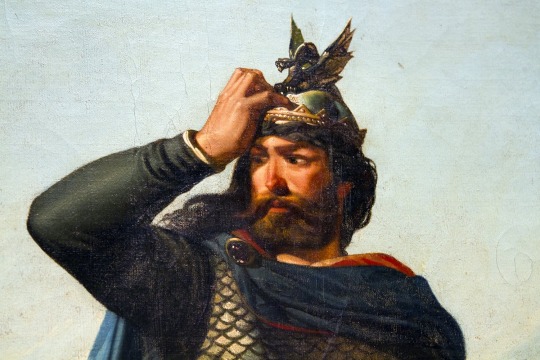
King Roderick at the Battle of Guadalete (711) by Marcelino de Unceta y López
#king#roderick#roderic#visigoth#visigoths#visigodos#rodrigo#visigothic#iberia#art#painting#history#europe#european#christian#battle of guadalete#hispania#spain#spanish#marcelino de unceta y lópez#umayyad#conquest#muslim#moors#marcelino de unceta
61 notes
·
View notes
Note
You are incredibly racist, GRRM himself has said that the closest equivalent of Dorne to the real world is the Moorish influences of Spain, and mentions PALESTINE and Wales as being two other influences. Literally his own words. Even in Game of Thrones, they filmed the Water Garden scenes in the Alcazar of Seville, a beautiful Moorish castle in Spain. That castle was literally built by Muslims and incorporates verses from the Quran and countless traditional Arabic and Islamic architectural elements. Fun fact: Alcázar comes from the Arabic word (al-qasr), meaning fort/castle/palace.
Dorne’s conquest by Nymeria parallels Spain’s conquest by the Moors. Nymeria Martell most obviously can be paralleled with Tariq Ibn Ziyyad, the Muslim Amazigh general hailing from Morocco that led the Muslim conquest of Spain on behalf of the Umayyad Caliphate, by crossing the Mediterranean sea and landing in Gibraltar. According to legend, Tariq Ibn Ziyyad burned his fleet before the Battle of Guadalete to prevent any of his troops from retreating back home. Who else burned their fleets to show commitment to their new conquest ? Nymeria Martell.
GRRM credits the “hot, dry” climate to being similar to that of Spain or Palestine’s, and that the mountains where the stony Dornishmen dwell being the equivalent to Wales. The Sandy Dornishmen are described to dwell in the deserts and along rivers, which is a descriptor that describes so many parts of West Asia (incorrectly called the “Middle East”) and North Africa. GRRM mentions Palestine, which has many streams and a very important river, the River of Jordan, as well as the Naqab region, a desert region of Palestine, therefore drawing parallels from the Sandy Dornishmen to the Palestinians is correct since Palestine is sandy, dusty, and dry. Finally, there’s a Stony Dornishmen, which GRRM equates to Wales.
*EDITED POST* (4/14/24)
I assume that this is the post you are responding to.
We must remember that the rules determining what racial group you are a part of is solely determined by the legal definitions of the created designations of "white", "mestizo", "Black", or whatever said society has created in their past and present. which is why when you travel, you sorta change race or have it "tweaked" to mean something else. In Westeros, there is not such legal, social, etc. concept of race that matches the modern U.S.A or any European definition. If you said Corlys was "Black", it would mean nothing to a Stark.
Race is also different from ethnicity or nationality: you can be Paelstinian Arab but or a Black American but be white passing enough to "become" white. You can be of East Asian descent and have monolids to be racialized as "Asian", but were born and partially raised in Germany (nationality) with the ethnicity of Uyghur.
Definitions of racism:
(Google)
prejudice, discrimination, or antagonism by an individual, community, or institution against a person or people on the basis of their membership in a particular racial or ethnic group, typically one that is a minority or marginalized
the belief that different races possess distinct characteristics, abilities, or qualities, especially so as to distinguish them as inferior or superior to one another
(Merriam Webster)
a belief that race is a fundamental determinant of human traits and capacities and that racial differences produce an inherent superiority of a particular race
This is from GRRM about "race" in ASoIaF and the Dornish:

Did GRRM ever actually say the words, "stony Dornish men are a completely different ethnic group from sandy or salty" or that "stony vs salty vs sandy Dornish people--apart from the nonDornish peoples' ways of categorizing them--are peoples with very different and maybe opposing customs the reflect in certain "laws" in Dorne"?
For the Martells and Dornishpeople to be PoCs exactly like the PoCs today in real life, there kinda has to be a history of a) the Dornish having been assimilated into Westerosi society/infrastructures and made subordinate to the "white" Westerosi b) actual systematic oppression against the Dornish from the nonDornish, and Dorne has been able to maintain its independence from Westeros pretty much since Westeros' inception. Even after Daeron II married Myriah Martell, the Martells and the Dornish still worked as their own principality rather than a region totally under the control of the Westerosi monarchy. There was no colonization or successful imperialist campaigns on Dorne. Like the Targs, Dorne is "queer" not for skin color nor religion so much as the Rhoynish traditions towards gender equity--at least regarding succession and leadership--and sexuality
I argued for how the Westerosi see the Dornish, which is not like how medieval EUs saw non-Christian Africans or Arabic-speaking Muslims. It is how Anglo Saxon Normans would have seen Spanish/Eu Mediterraneans. Watsonianly. This is a question of who are the people categorizing "race", and how is "race" categorized by those people.
There is tension b/t Stormlanders/Reachmen and the Dornish people (mostly Stony Dornishmen of the north) but it's hardly equivalent to what is known as "race". Not yet. Daeron I's categorization is a beginning, A PRECURSOR. With how Daeron II's subjects rebelled with a strong anti-Dornish sentiment (not enough misogyny [succession rules] & and a persistent sense of having court & office positions "taken" from the "local" nobles) the Otherness indicates a xenophobia but here is no concept of "white" or "PoC" anywhere.
I have also already addressed the whole stony vs salty vs sandy thing HERE and HERE. In both of those posts, I acknowledge that there are Islamic and Arabic inspirations for the creation of Dorne and I still recognize them there. And the Rhoynish (mot the Martells or any Dornish people) are definitely PoC. It's pretty obvious. But Dornish people--including the Martells--while descended from the Rhoynish and Rhoynisheness definitely determine how nonDornish perceive and identify Dornish people, are not racialized as today's PoCs are. They are closer to how Jewish, Spaniards, Mediterranean Europeans, and Southern European Europeans are racialized by Northwestern Europeans.
Those monikers Daeron I gave distinguished them based on appearance alone, hence the beginning of skin-color-race in terms of how much Rhoynish culture and blood mixed with the previous Andal-only people's, more of the Rhoynish cultural influence the more you go south and less when you go north. If you called a Wyl (example of a Dornish house of the north) anything something other than Dornish and just called them a "stony" Dornishman, I think they'd take offense.
Once again, when we see how the concept of race developed from religion to skin color, in Spain, you see that religion was the first way for medieval people to differentiate themselves into "races"--and when they used the word "race", they meant just "people from that region/religion/history", not necessarily people with such looks--more than skin color (though color was sometimes mentioned alongside, to identify, so as to say that this African was "safer").
Then there is the fact that there were intermarriages between Arabic-speaking, Muslims, Africans to be called "Moors" (a word from Christian Europeans of the pale variety, not those peoples) and with Catholic Spaniards. Today, Spain is considered a white European country even with its numerous ethnicities and history of conquest by the Umayyad Caliphate. Dorne, in autonomy and a unit of territory, is like both Wales and Spain. Today, European regions that are considered, racially, white.
Doylistically, while the narrative gets its inspiration from real life PoCs architecture and figures, the fact that Dorne, wherever you go even with the different levels of Rhoynish influence, is an amalgamation of Andal and Rhoynish that still has that Andal Seven/Catholic religion, and the Common tongue (Rhoynish is not spoken by most people in Dorne except the Green blood bc the Red Princes outlawed it) set up universally despite equal primogeniture and tolerance of homosexuality/extramarital sex means that those things that precede race-by-face/skin and then set up the basis for race-of-skin/face (religion, language, customs) does exactly not resemble what happened for the same as real life (again, Spain is not a PoC country in spite of the Umayyad conquest and influence).
Again, to me it felt like they are socially Othered how Jewish and Welsh, Scot, Irish, etc. people are Othered in Europe...not in modern times but in the context of various medieval English regions temporally and geographically. Again, Watsonianly. But there's strong argument for the other. While they are definitely Othered and have PoC inspiration and but they aren't Othered in their world like PoCs are Othered.
Either way, I don't think GRRM is conveying that Rhaegar left Elia specifically because he thought she was racially inferior to himself or wasn't owed respect due to her Dornishness. Which I already argued was untrue in the linked post above for the history that Tags and Martells have. And which was the point of me even bringing up race and Elia, since that was the argument Elia-supporters-Rhaegar-bashers have.
9 notes
·
View notes
Photo
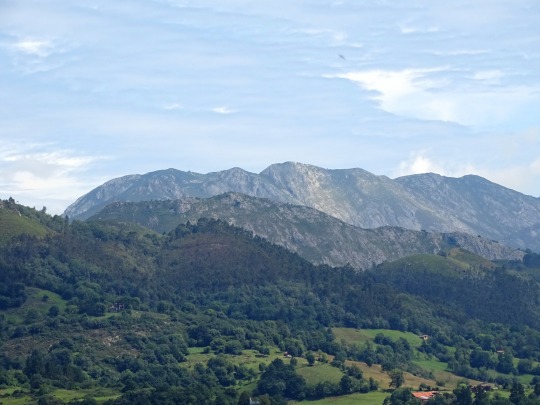
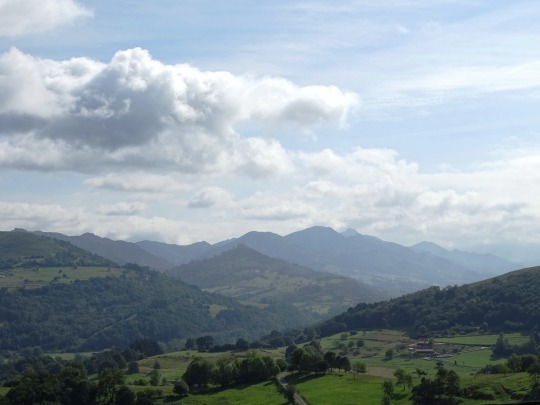
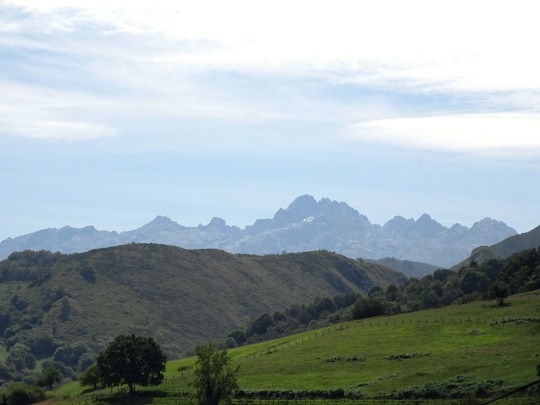

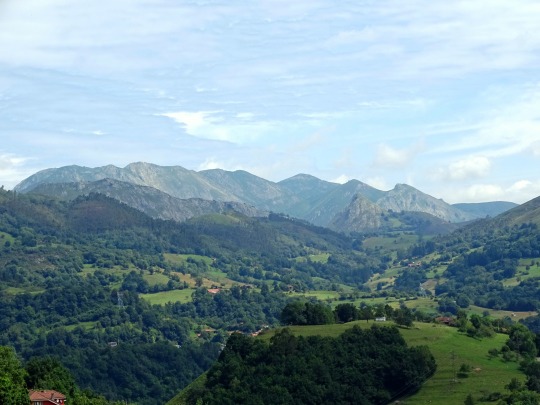
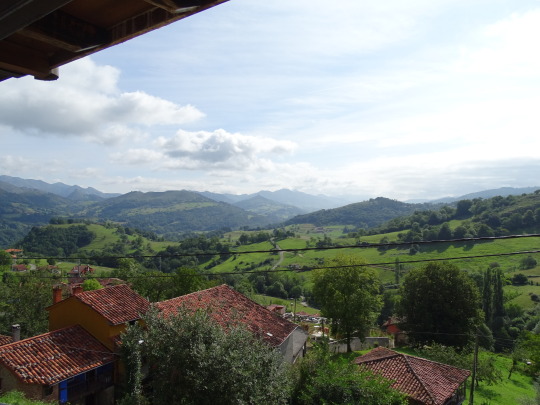
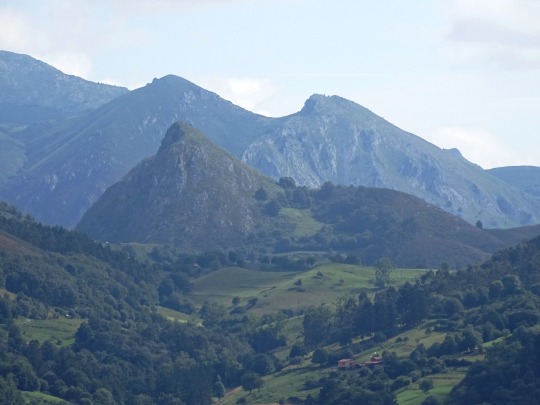
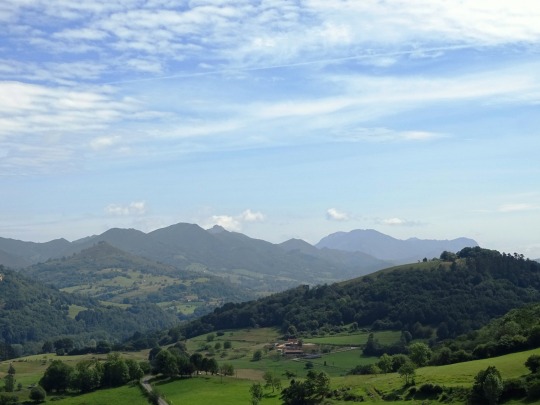
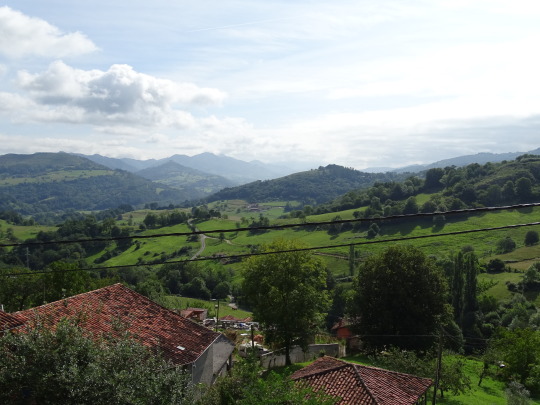

Cangas de Onís, Spain (No. 2)
Cangas de Onís is a municipality in the autonomous community of the Principality of Asturias, Spain. a parish of that council; capital of the council; and one of the 18 judicial districts of Asturias.
The council of Cangas de Onís limits to the north with Parres and Ribadesella, to the east with Onís and Llanes, to the west with Amieva and Parres and to the south with the province of León. The motto that collects its shield is "Minima Urbium Maxima Sedium". It has a population of 6209 inhabitants (INE, 2020). In 1908 Cangas de Onís was granted the title of city.
Cangas de Onís was the capital of the Kingdom of Asturias until 774. In this population King Don Pelayo was established, and from here he undertook with his people actions on the territories of northern Spain, as the only focus of resistance to Muslim power, once the Visigothic Kingdom disappeared. In this municipality took place in the year 722 the battle of Covadonga, where Don Pelayo defeated the Muslim forces and consolidated a power and prestige that allowed him to remain independent and found the first Christian kingdom after the defeat of the Visigoths in the battle of Guadalete.
More than 2000 hectares of the council are part of the Picos de Europa National Park. Within the park is the monumental complex of Covadonga, where the Reconquest began in 722. 12 kilometers from Covadonga are the so-called lakes of Covadonga (there are three: the Enol, the Ercina and the Bricial, although this only has water during the thaw), of great relevance in the cycling field. In the capital of Cangas de Onís is the so-called "Roman Bridge", although its construction actually dates back to the Middle Ages.
The population of Cangas de Onís is settled at the junction of the rivers Sella and Güeña, the latter being a tributary of the former. In the valley between both rivers is the chapel of the Holy Cross, which was a temple of Roman times, rebuilt during the reign of Favila de Asturias.
Source: Wikipedia
#Cangas de Onís#Asturias#Parque nacional de los Picos de Europa#Picos de Europa#Cantabrian Mountains#Cangues d'Onís#landscape#Spain#countryside#forest#woods#meadow#mountain village#architecture#roofs#overcast#tourist attraction#summer 2021#original photography#España#Northern Spain#Southern Europe#clouds#nature#flora
7 notes
·
View notes
Text
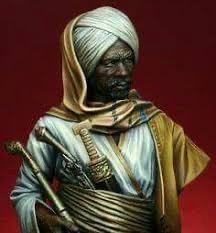
Ṭāriq ibn Ziyād (670-720) known simply as Tarik in English, was a Berber Umayyad commander who initiated the Muslim Umayyad conquest of Visigothic Hispania (Spain and Portugal) (711–18) AD. He led a large army and crossed the Strait of Gibraltar from the North African coast, consolidating his troops at what is today known as the Rock of Gibraltar. The name “Gibraltar” is the Spanish derivation of the Arabic name Jabal Ṭāriq, meaning “mountain of Ṭāriq”. On or about April 26, 711, his army composed of recent Berber converts to Islam, was landed on the Iberian peninsula by Julian. They debarked at the foothills of a mountain that was henceforth named after him.
It should be noted that many modern historians tend to refer to Tarik’s garrison as consisting only of Caucasoid Berbers and Arabs. Ibn Husayn of the 10th Century recorded however that many of his troops were “Sudanese”. Contemporary accounts of Europeans state of the Moorish invaders, “Their faces were as black as pitch, the most handsome amongst them was as black as a cooking pot.” It should be pointed out that the term “Berber,” erroneously identified as a racial category, is in actuality a linguistic-ethnic group. There are both Semitic and African Berbers. He was described by contemporary witnesses as having a short stature, brown skin, a hooked nose, and woolly hair. He was said to be a native of Sudan. Thus would begin the Moorish occupation of Spain, to which Europe owes greatly the benefits of the Renaissance, which would last well into the 15th Century.
His army contained about 7,000 soldiers, composed largely of Berber stock and Arab troops. Roderic, to meet the threat of the Umayyads, assembled an army said to number 100,000. He won a decisive victory when Roderic was defeated and killed on July 19 at the Battle of Guadalete.
He split his army into four divisions, which went on to capture Córdoba under Mughith al-Rumi, Granada, and other places, while he remained at the head of the division that captured Toledo. He continued reaching Guadalajara and Astorga. He was de facto governor of Hispania until the arrival of Mūsā. #africanhistory365 #africanexcellence
0 notes
Text
Events 7.19 (before 1900)
AD 64 – The Great Fire of Rome causes widespread devastation and rages on for six days, destroying half of the city.
484 – Leontius, Roman usurper, is crowned Eastern emperor at Tarsus (modern Turkey). He is recognized in Antioch and makes it his capital.
711 – Umayyad conquest of Hispania: Battle of Guadalete: Umayyad forces under Tariq ibn Ziyad defeat the Visigoths led by King Roderic.
939 – Battle of Simancas: King Ramiro II of León defeats the Moorish army under Caliph Abd-al-Rahman III near the city of Simancas.
998 – Arab–Byzantine wars: Battle of Apamea: Fatimids defeat a Byzantine army near Apamea.
1333 – Wars of Scottish Independence: Battle of Halidon Hill: The English win a decisive victory over the Scots.
1544 – Italian War of 1542–46: The first Siege of Boulogne begins.
1545 – The Tudor warship Mary Rose sinks off Portsmouth; in 1982 the wreck is salvaged in one of the most complex and expensive projects in the history of maritime archaeology.
1553 – The attempt to install Lady Jane Grey as Queen of England collapses after only nine days.
1588 – Anglo-Spanish War: Battle of Gravelines: The Spanish Armada is sighted in the English Channel.
1701 – Representatives of the Iroquois Confederacy sign the Nanfan Treaty, ceding a large territory north of the Ohio River to England.
1702 – Great Northern War: A numerically superior Polish-Saxon army of Augustus II the Strong, operating from an advantageous defensive position, is defeated by a Swedish army half its size under the command of King Charles XII in the Battle of Klissow.
1817 – Unsuccessful in his attempt to conquer the Kingdom of Hawaii for the Russian-American Company, Georg Anton Schäffer is forced to admit defeat and leave Kauai.
1821 – Coronation of George IV of the United Kingdom.
1832 – The British Medical Association is founded as the Provincial Medical and Surgical Association by Sir Charles Hastings at a meeting in the Board Room of the Worcester Infirmary.
1843 – Brunel's steamship the SS Great Britain is launched, becoming the first ocean-going craft with an iron hull and screw propeller, becoming the largest vessel afloat in the world.
1845 – Great New York City Fire of 1845: The last great fire to affect Manhattan begins early in the morning and is subdued that afternoon. The fire kills four firefighters and 26 civilians and destroys 345 buildings.
1848 – Women's rights: A two-day Women's Rights Convention opens in Seneca Falls, New York.
1863 – American Civil War: Morgan's Raid: At Buffington Island in Ohio, Confederate General John Hunt Morgan's raid into the north is mostly thwarted when a large group of his men are captured while trying to escape across the Ohio River.
1864 – Taiping Rebellion: Third Battle of Nanking: The Qing dynasty finally defeats the Taiping Heavenly Kingdom.
1870 – Franco-Prussian War: France declares war on Prussia.
1900 – The first line of the Paris Métro opens for operation.
0 notes
Text
Another in the sequence of Spanish history wrapped up:
It covers exactly what the title says, the history of Spain from the rise of the Visigothic kingdom to the reign of Ferdinand and Isabella, the Catholic Monarchy. Spain, like Russia and Sicily, stands out in terms of European history as a prime example of colonialism and imperialism targeting European societies in the medieval era. And in the grim irony that the cultures targeted by it went on to become the master imperialists on the European fringes.
On the one hand there is a dramatic tale of a clash of civilizations beginning with Tariq Ibn Zayid's conquest of Al-Andalus at the Battle of Guadalete, to the great clashes like Las Navas De Tolosa, to the final fall of Granada. Spanish Islam in turn very much was a colonialist enterprise marred by Islam's shift from an aristocratic ethnic Arab religion to a universal religion, the deep and bitter strife of Arab tribes, and Arab-Berber-Mozarabic strife, multi-sided and unpleasant for everyone.
Spanish Christianity worked for a very long and bloody process as often allied to individual Muslim lords as their enemies to go from a frontier kingdom where the Muslims didn't want to march to lords of most of the peninsula. The old unity of the Visigothic state, in turn, would ultimately fade and in the end but two kingdoms would be left, Spain and Portugal. The process to get there in a sequence that included Asturias, Leon, Castile, Navarre, Portugal, Aragon, and a few smaller, more ephemeral kingdoms, was a bloody and convoluted mess.
At the start Spain was a region led by a deeply divided aristocracy that exploited the full aspects of the kingdom as much as their divisions allowed, which was less than it seemed. By the end of it the union of Castile and Aragon was developing an empire in and out of Europe, while Portugal had led the way to the overseas colonialism and the slave trade that would mark the onset of modern history.
9/10
1 note
·
View note
Video
youtube
The lessons of Roman, Visigothic, and Arabic Spanish History
History is an amazing teacher. While current events and my personal engagement in Catholic social ministry in New York City defines my professional experience I am also a part-time academic with a passion in the subjects of theology, ethics and history. I personally do not see this as a distinct interest or hobby. My experience at the Catholic Theological Union introduced me to academic learning that saw the interconnectedness of various distinct subjects. On Saturdays we would have the opportunity to reflect on the various courses we were taking (History, ethics, scripture, spirituality etc.) and reflect on the points where our learning would converge and what that would mean for us. So it is that I am able to continue this practice of seeing how one academic insight could help me see a contemporary situation from a new perspective.
I have always found Spanish history fascinating, especially from its late Roman period throughout the Middle Ages. On the one hand there is something romantic and enduring about its struggles throughout this period. But there is also something very tragic as well. As I read these books below It amazed me how the authors explored the social and political development of these three different dominant cultures who dominated the peninsula, the Romans, Visigothic and Arabic conquerors. There are many amazing moments of creative development where these cultures attempted to integrate themselves with the people who lived here. Rome used its cultural heritage and militaristic discipline to attract loyalty. The Visigoths utilized the Church to maintain social order while leaving former local cultural norms alone to keep the community at peace. The Arabs employed gradualism that initially rewarded loyalty with a degree of local cultural freedom. The Romans were perhaps the most successful at employing a common code of law for the entire community but it was conducted in a way that benefitted Romans over local tribes. The Visigoths opted to have a different legal systems for the Germanic and Romano-Hispanic communities. The Arabs would also have a similar legal distinction between the Islamic and non-Islamic faith communities but they would also have a tax system that would burden their non-Islamic subjects.
This form of legal and economic segregation was not successful in the long run. The Romans maintained an ethnic cultural distinction with non-Romans including the Germanic peoples. The Visigoths were clearly segregated and given no social benefit beyond the periodic gifts bestowed on their leaders. This would result in unifying the various Germanic tribes against the Romans and one tangible expression of the this was the sack of Rome by Alaric and his Visigoths in 410. These Visigoths would then move west and take over southern Gaul and the Hispanic peninsula later that century.
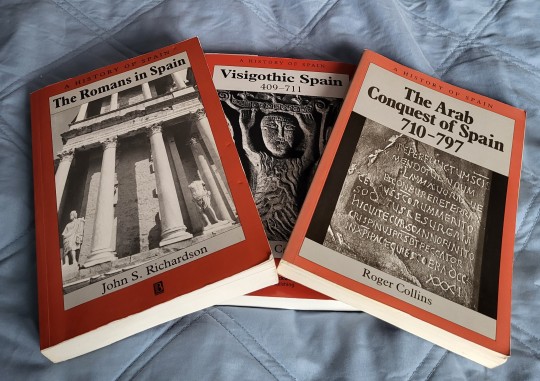
But in all this time there never seemed to be a real interest in integrating the local communities. There is little to almost no existing narrative regarding who the Hispanic tribes where besides some tribal names during the Roman period. But what is obvious is that at every moment that a new dominating conqueror comes on the scene there is almost no loyalty that exist with the former regime. The Battle of Guadalete in 711 is a perfect case in point. This was exacerbated by the fact that the Visigothic leadership was in constant turmoil and open to treachery. The Visigoths had an appalling system for establishing leadership and succession, it’s very surprising that they were able to unify the peninsula as they did. Based on the rapid conquest of 711 I suggest that the “unity” that did exist was very superficial.
The Islamic conquest was nevertheless quite remarkable because in a very short time almost the entire peninsula was taken over. Even the Romans could not boast such a quick accomplishment. By 732 the Islamic armies confronted the Frankish armies of Charles Martel in the Battle of Tours where they were finally halted. Remarkably, these conquerors would face internal division that would occupy them the moment that conquest was done between Syrian Arabs and North African Berbers. Unity, it seems, is not a characteristic of the Hispanic Peninsula just like it continues to evade us in the Latin American region.
Integration and inculturation are powerful forces that are not part of the historical narratives of early medieval Spain. This is something that we can see is to the great loss of those who claimed to me conquerors and who always defined themselves separate from those wanted to rule over. The general population usually served as conscripts, labor or taxes. They were seen as a means for holding on to power, and nothing else.
The difference in the historical narrative occurs when a remnant of Christian Hispanic/Visigothic resistance emerge in 718AD after the legendary Pelagius defeats an Arab army in the Battle of Covadonga. This resistance occupies a small region, known as the Kingdom of Asturias that is allowed to develop and reorganize their entire community. At that level, where survival is very much at stake, integration and inculturation are no longer an option but a necessity. Unfortunately, as soon as a dynastic power emerges from the ashes (the dynasty of Alfonso I) a power struggle ensues and in the case of Asturias they would soon have a contentious relationship with the Galician and Basque community within a span of a couple decades.
There is an historical lesson here. For power to be effective in the long term the various communities need to feel like they are integrated with one another. They need to feel that they are part of a meta-culture that speaks to all different ethnicities. This, I believe, is one of the enduring problems for the chaos of early medieval Spain and also for the current Latin American situation. Here in the United States we must make sure to value the integration and inculturation of all people and not be tempted in rewarding certain nativist communities with more social benefits than others. We know that a politics of fear is spreading which keeps us from integrating our diverse neighbors and instead is leading us to a form of ethnic tribalism where certain values and social benefits are narrowly defined for the interest of a native community (and maybe their friends).
Pope Francis warns us about embracing these politics of fear and he uses images from our medieval history to make this point.
Today too, outside the ancient town walls lies the abyss, the territory of the unknown, the wilderness. Whatever comes from there cannot be trusted, for it is unknown, unfamiliar, not part of the village. It is the territory of the “barbarian”, from whom we must defend ourselves at all costs. As a result, new walls are erected for self-preservation, the outside world ceases to exist and leaves only “my” world, to the point that others, no longer considered human beings possessed of an inalienable dignity, become only “them”. Once more, we encounter “the temptation to build a culture of walls, to raise walls, walls in the heart, walls on the land, in order to prevent this encounter with other cultures, with other people. And those who raise walls will end up as slaves within the very walls they have built. They are left without horizons, for they lack this interchange with others”. (FT, #27)
Notice how his warning is to the social ramifications of those who build these modern day walls. Again this is a lesson straight out of history. While the Romans, Visigoths and Arabs saw themselves as protecting their own power-base by keeping themselves separate from the conquered communities the historical reality is that they never were able to achieve their own stability and once their foundations were shaken they would easily crumble.
0 notes
Text
Al Andalus: The dawn of one of the worlds greatest civilizations.
Other Parts:
Al Andalus I: The dawn of one of the world’s greatest civilizations.
Al Andalus II: One of the world’s greatest civilizations; Times of Glory, Part 1.
Al Andalus II: One of the world’s greatest civilizations; Times of Glory, Part 2.
Al Andalus III: One of the world’s greatest civilizations; The Downfall and end, Part 1.
Al Andalus III: One of the world’s greatest civilizations; The Downfall and end, Part 2.
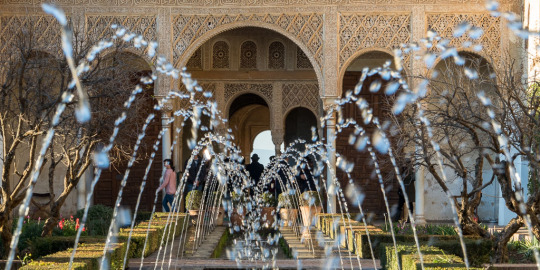
Photo
The beginning:
The name al Andalus is used to describe Spain and Portugal or the Iberian “peninsula” in the time when the Muslims dominated the region. Today it is the name of a province in southern Spain. The word Andalucía originates from some Viking tribes that populated south of Spain in the Visigothic times. This tribe was called Vandal that later changed into Andal, Vandalucia > Andalucía. Vandalism originates from this word.
In the years leading up to the time the Muslims entered Spain, the situation was miserable, to say the least! The Visigothic King Witiza had recently passed away and according to their customs the throne was not inherited but rather elected. The fruitless attempt to to make the crown inheritable had failed miserably because of the opposition of the nobles. In the election Rodericus (Rodrigo) won the most votes which according to their law automatically meant that Rodrigo was to be the new legitimate king, but not without a fight!
His rival, Agila II also had big support from fractions of the nobles, the fight almost resulted in a civil war.
In the middle of this instability, end of the year 710 AC. Rodrigo became the new king.
As if this was not enough, alongside the country’s bad economic situation, the late king Witiza had confiscated the Jews properties which led to an uprising.
Added to this, there were serious problems with the church and the previous decade was filled with several famines and the bubonic plague had claimed a significant portion of the population.
Instability, both political and economic, as well as injustice, famine, and death, this was the state of the country just before the arrival of the Muslims to the Iberian peninsula.

Photo
The two leading figures:
Mousa ibn Nysayr contributed greatly to the unification of Northern Africa, with Morocco being the last country to be taken, further to the west was nothing but the Atlantic Ocean.
Now, the caliphate army looked north, towards Spain.
Mousa ibn Nysayr was born in Syria (640-716 AC.), his father, Nysayr, was a converted Muslim born Christian.
Mousa served as a general in the Ummayan caliphate, he ruled over provinces in North Africa.
Tariq ibn Zijad, was also a general, but from Berber origins.
He was tall, blond, with blue eyes, he was handsome and very enthusiastic, and he spoke both Berber and Arabic.

Photo
The preparation:
General Mousa left his general, Tariq, to govern Tangier in his place for a period of time.
When the thought finally came, to continue their conquest further into Spain, they faced several problems.
The first problem was that they did not have enough ships to cross over the Mediterranean Sea, from Morocco to Spain.
Therefore, general Mousa ordered the construction of ships at Kairouan city (tunisia), as many of them as possible.
Nonetheless, the construction took time and he had to find an alternate solution besides the already ordered construction.
At that time , the governor of Septa, was an exiled man called Julian. He had been a close ally to the late King Witiza but he was hostile to the new King Rodrigo, who according to Julian was illegitimate because he ascended to the throne through a military coup.Enemies as they were , Rodrigo confiscated Julians and his sons properties in Spain after sending him into exile to Septa.
Julian, who wanted his possessions back in addition to the hatred he had for Rodrigo, started negotiations with General Musa, as a solution for himself. He offered to hand over Septa to the Caliphate and to lend them the ships they needed; lastly he would provide them with inside information of the situation in Spain at the time. In return he wanted his and his family’s possessions in Spain returned to him if the Muslims were to win the battle.
With Julian , now an ally, General Musa wanted to eliminate another potential threat in the future “the Balearic Islands”. These islands were independent from the rest of Spain and were still under Roman rule. General Musa decided to conquer the Balearic island before going further to al Andalus. General Musa won the battle and lost an enemy.
With two new allies, sufficient ships, an army of 7,000 men and after having studied Spanish geography for one year general Musa was ready to start the war!
General Tarif ibn Malik was send in first with 500 men in a reconnaissance mission, that was successful.
Finally, after all the preparations, general Tariq and his men crossed the Mediterranean and landed in a part of Spain, now known as Gibraltar. Named after general Tariq ( gibl= mountain in Arabic + Tariq) = Tariq’s mountain.

Rock of Gibraltar
The battle of Guadalete:
The battle started in a place that Tariq carefully had chosen, a place called Guadalete. The reason for choosing this place was that it was surrounded by mountains on one side and a lake on the other side, leaving only the north open for the enemy to enter. In this way general Tariq was in control of the battle. This was especially important as al Andalus was rich in mountains, rivers and rough terrain that made the advances difficult. The Visigothic army consisted of 100,000 men against the caliphate army that counted 7,000 men, mainly Berber soldiers with general Tariq ibn Ziyad as their commander.
The caliphate army lost 2,000 men in the battle but surprisingly King Rodrigo’s army lost much more and in the end he was either killed in battle or he had to escape, there are various narrations to the story.
However the case, the Caliphate’s army (as they arrived on ships) came without horses, in the aftermath of the battle they ceased their enemies horses and kept marching to Seville, Jaén, Cordoba and Mérida, most of these cities gave up without a fight, they simply opened the gates to the city. During the whole advancement into Spain, the most surprising fact was the lack of resistance. The reason therefore, as mentioned earlier, was the poor living conditions that the population had experienced during the Visigothic rule. They had hope in the new country, as it could not possibly get any worse.
In that time Toledo being the capital of Spain or Hispana( as it was called before the Muslim rule) general Tariq and his army continued marching north towards Toledo. Simultaneously the rest of the troops opened up further pockets as well as assuring the peace in the already occupied territories.when general Tariq and the army arrived in Toledo, they were surprised to discover that the gates of the city were opened, they entered and took control of the city without any resistance.
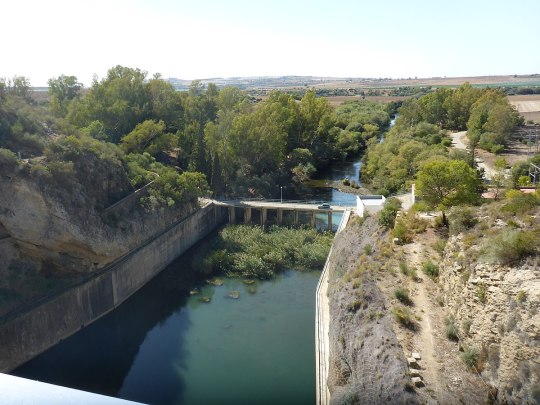
Guadalete river
As a result of the quick progress general Musa sent a message telling general Tariq and the troops to halt further advances and to wait in Toledo for further instructions.
General Musa wanted to stabilize the country before any further advance, he had learned from his mistakes in North Africa in earlier years.Spain was as the rest of Europe in this time in the dark ages, poor, unsanitary and under-educated, and general Musa understood that education was of essential importance to stabilize the country.
During this time Portugal surrendered to general Musa’s son general Abdelaziz Musa ibn Nysayr.
The last push:
After approximately a year of pause the advances continued and this time general Musa brought with him 18,000 new recruits, these recruits were mainly Arabs unlike the first army that consisted of Berbers,and joined general Tariq for the last push.
Heading north they entered cities like Zaragoza and Barcelona before reaching the Pyrenees, this whole operation took 3.5 years . With just a small area left, Asturias, they received an order from the Caliphate or Amir il mohmeneen, commanding them to return to Damascus without delay, as the Amir thought the situation was escalating far too quickly!
This is the reason the small piece of Asturias never became a part of al Andalus, contrary to what some people claim that the resistance there was too fierce for the Caliphate’s army! Al Andalus was now under the Caliphate of Damascus rule!!!
#spain#al andalus#history#toledo#andalucía#battle of guadalete#guadalete river#granada#vicegothics#khalifates#ummayah#giblartar#musa ibn nysayr#tariq ibn zijad
16 notes
·
View notes
Note
Nymeria Martell most obviously can be paralleled with Tariq Ibn Ziyyad, with Dorne and Spain being their respective conquests. He was the Muslim Amazigh general hailing from Morocco that led the Muslim conquest of Spain on behalf of the Umayyad caliphate, by crossing the Mediterranean sea and landing in Gibraltar. Fun fact, according to the legend, Tariq Ibn Ziyyad burned his fleet before the Battle of Guadalete to prevent any of his troops from retreating back home. In his famous speech, he says: “Oh my warriors, whither would you flee ? Behind you is the sea, before you, the enemy.” You know who else burned their fleets to show commitment to their new conquest ? Nymeria Martell.
Ah I love historical inspiration!
Thank you for this information I had no idea but I love it.
47 notes
·
View notes
Note
White ASOIAF fans are incredibly racist. GRRM himself has said that the closest equivalent of Dorne to the real world is the Moorish influences of Spain, and mentions Palestine and Wales as being two other influences. Literally his own words. Even in Game of Thrones, they filmed the Water Garden scenes (a private retreat to House Martell) in the Alcazar of Seville, a beautiful Moorish castle in Spain. That castle was literally built by Moorish Muslims and incorporates countless traditional Arabic and Islamic architectural elements.
Dorne’s conquest by Nymeria parallels Spain’s conquest by the Moors. Nymeria Martell most obviously can be paralleled with Tariq Ibn Ziyyad, the Muslim Amazigh general hailing from Morocco that led the Muslim conquest of Spain on behalf of the Umayyad Caliphate, by crossing the Mediterranean sea and landing in Gibraltar. According to legend, Tariq Ibn Ziyyad burned his fleet before the Battle of Guadalete to prevent any of his troops from retreating back home. You know who else burned their fleets to show commitment to their new conquest ? Nymeria Martell.
Dorne is a region of the world made up of three different ethnic groups: the Salty, Stony, and Sandy Dornishmen. Here’s the full description from AWOIAF: "The stony Dornishmen were the mountain folk, fair of hair and skin, mostly descended from the First Men and the Andals; the sandy Dornishmen dwell in the deserts and river valleys, with their skin burned brown beneath the blazing Dornish sun; the salty Dornishmen of the coasts, dark-haired and lithe and oliveskinned, have the queerest customs and the most Rhoynish blood."
GRRM credits the “hot, dry” climate to being similar to that of Spain or Palestine’s, and that the mountains where the stony Dornishmen dwell being the equivalent to Wales. The Sandy Dornishmen are described to dwell in the deserts and along rivers, which is a descriptor that describes so many parts of West Asia (wrongly called the "Middle East") and North Africa. GRRM mentions Palestine, which has many streams and a very important river, the River of Jordan, as well as the Naqab region, a desert region of Palestine, therefore drawing parallels from the Sandy Dornishmen to the Palestinians is correct (as someone who’s lived in and travelled Palestine extensively, believe me when I say that most of it is sandy, dusty, and dry). Finally, there’s a Stony Dornishmen, which GRRM equates to Wales.
This is very informative.
This shows both however, how white fans are racist and ignorant but also how GRRM himself is also racist in his own coding and characterization. on my other blog i've spoken in depth about the racism regarding the dothraki and even the dornish people. GRRM really went out of his way to negatively portray primary groups of color.
but aside from that, thank you so much for all of this information.
7 notes
·
View notes
Text
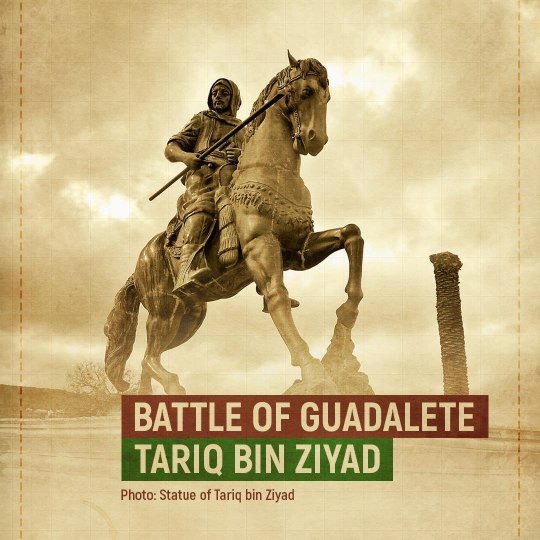
On the 27th of Ramadan, 92 Hijri (July 19, 711), Berber Umayyad commander, Tariq bin Ziyad defeated king Roderic of the Visigothic Kingdom at the Battle of Guadalete (in southern Spain).
This victory of Tariq marked the beginning of the Umayyad conquest of Hispania. King Roderic was also killed in the battle. The Iberian peninsula soon became part of the expanding Umayyad empire, under the name of al-Andalus.
After the fall of the Umayyads in the east in 750 CE, Abd al-Rahman I, a member of the Umayyad dynasty, refused to recognize the authority of the Abbasid Caliphate and fled Damascus. As a result, in 756, he established the Emirate of Córdoba and became an independent emir of Córdoba.
The Nasrid Kingdom of Granada was the last independent Muslim state in Western Europe, which ruled from 1230 to 1492. After its fall in 1492, the new Christian state of Spain took a very aggressive religious conversion approach against the non-Christian population of the Iberian peninsula. Both the Jews and the Muslims were forced to convert and then be expelled as part of the Spanish Inquisition.
Join us on Telegram
https://t.me/fiveminthistory
Support us
https://www.patreon.com/fiveminthistory
1 note
·
View note
Text
Culture in Focus: Al-Andalus; an overview of Muslim rule in The Medieval Iberian Peninsula (Spain/Portugal) (711-1492 AD) Part I: A confluence of peoples and traditions...
The historical memory of Medieval Europe is varied in terms of focus and broader knowledge in the modern era. The cultures and various peoples that existed during the centuries known as the Middle Ages are varied and rich in complex interwoven societies. The focus of this post shall be what constituted the primary polity for much of the Medieval period in the Iberian Peninsula of southwestern Europe, in modern day Spain, Portugal, Andorra and even the south of France. Though we more or less regard these countries today as traditionally bastions of the Roman Catholic religion with Latin based Romance languages. The fact is from the early 8th to nearly the end of 15th centuries, the Iberian Peninsula had been dominated by an Islamic polity, one in which Arabic was the lingua franca among the elites and the majority population of parts of the peninsula were Muslim, with Christians and Jews living and interacting within that society too, at times relatively harmoniously and other times violently. A well honed hierarchy was established between the three Abrahamic religions and a complex society was formed that lead to some of the most advanced and cultured learning in language, literature, history, science, math, art, religion, philosophy and economics during the Middle Ages took place. That society and region became known as Al-Andalus, the Arabic word from which the region of southern Spain known today as Andalusia takes it name.
Al-Andalus came to be the confluence of many societies in an era so often viewed in black and white terms of an us versus them portrayal between Christianity and Islam. Indeed, these two religions would drive events in and define many aspects of society in Al-Andalus but they were not the sole factors in its being. In fact, it was the fall of the Western Roman Empire during the 5th century would in part set the stage for Al-Andalus. The Roman Empire has been the world’s foremost political, cultural and military superpower, certainly in Europe for several centuries. However, internal strife, corruption and civil war had lead to the empire being divided and co-ruled between two halves, a Western and Eastern half. The empire had transitioned from Roman polytheistic paganism to Christianity with Rome itself being the symbolic head of Christianity with the Papacy. However, the West and East divide became a more practical than just symbolic division as the years rolled on. The Eastern capital became Constantinople and in time the Eastern Roman Empire known to history as the Byzantine Empire would persist in a largely Greek influenced context quite separate from the Latin influenced Western half although it would maintain Roman political machinations.
The year 410 was regarded as a watershed year, Rome, the Eternal City itself was sacked for the first time in 800 years, by barbarians. Namely, the migratory Germanic tribe known as the Visigoths. The Visigoths and the related Ostrogoths were part of a Germanic barbarian confederation called by the Romans, the Goths. They had possibly come from Scandinavia and northeastern Germany and moved down to the Balkans and eventually into Greece and Italy, alternately serving and fighting against the Romans as auxiliaries and eventually partial conquerors. The Visigoths under their King Alaric sacked Rome after a siege in 410 AD. Rome was not even the capital nominally of the empire at the time but the symbolic fall out was tremendous. Migrations of peoples over the next couple of centuries became the dawn of the Early Middle Ages also known as the Dark Ages when classical antiquity of Greece and Rome was said to be lost on the greater whole of Europe for centuries to come. Many of these migrations included Germans, Huns, Slavs and Avars among others. The Visigoths eventually moved from Italy into the south of France and the Iberian Peninsula. Long the Roman territories of Gaul and Hispania respectively, the locals were a mix of Celtic and Iberian peoples who intermixed with Romans and adopted Latin and other Roman cultural aspects. Now the powerful Visigoths ended their migration and established their own kingdom, the Visigothic Kingdom, long promised by those in Rome they had once served. Their Germanic language was the that of the political elite whereas the majority continued to speak the local dialect of Latin while the coexisting Jewish community spoke Hebrew and Aramaic. These descendants of Roman Jews from Judea and Syria and parts of Roman North Africa settled in Hispania forming a community that became known today as the Sephardic Jews. They were subjected to increasing persecution under their Christian overlords. The Visigoths themselves eventually adopted Christianity and for the next 300 years ruled the bulk of the Iberian peninsula.
The Visigoths continued many Roman traditions, such as bathing, use of aqueducts and indeed the Latin dialect persisted among the majority of the populace with the Germanic Goth language being relegated to the German minority in power. The Visigothic nobility was also quite learned and well versed in politics, history, philosophy and science, even later Muslim sources regarding the city of Seville attest to this, dispelling the notion that the ancient Germans were entirely barbarians with no education. However there were also political rivalries and civil war amongst its leadership. Overtime, the Visigoths were increasingly absorbed into the Hispano-Roman culture leaving only traces of their Germanic origins overall. By the time of the 8th century AD, these civil wars would weaken the state for new invaders.
Elsewhere in the world was the Arabian Peninsula and the various Arab tribes that inhabited it, long pagan and polytheistic, they also had Jewish and later Christian influences among their varied nomadic tribes. In the 7th century AD, an Arab named Muhammad begin preaching the core tenets of a new Abrahamic religion of which he was prophet, this religion became of course Islam and in its founders wake the new religion unified the Arabs and later spread rapidly throughout much of greater Eurasia and Africa, forming a religious-political empire known as a caliphate. In the midst of the rise of Islam, the Eastern Roman Empire was at war with the Persian Sassanian Empire for control of the Middle East, wars which exhausted both empires and with little concentrated military force on their southern borders, the Muslim armies post-Muhammad advanced within a few decades time from Arabia into Persia and the borders of India to parts of Anatolia, almost all of Palestine, Syria and Egypt and across the whole of North Africa to the Atlantic Ocean in modern Morocco. The Arab Muslim conquest overran Roman citizens who lived on the coast of North Africa and it also ran into locals, an Afroasiatic people who were the true native inhabitants of the Sahara Desert, various mountains and coastlines of North Africa. These people went by many names and were quite varied, divided into tribes and kingdoms known variously as Numidians, Libyans and Mauri among other names but were collectively, ethnically and linguistically related. They called themselves the Amazigh or “free people” but the Romans called them what translates today in English as the Berbers, a variation of the word barbarians. The Arabs and the Berbers began a long and complex history during the Muslim conquest of North Africa. Many Berbers gradually converted to Islam and many adopted Arab culture and language as part of a cultural synthesis, though the Berbers would retain their own ethnolinguistic and cultural traditions too. They remain the majority population of North Africa outside of Egypt to this very day. Also the view of all Muslims being Arab was challenged even in these early days. Arabs, Berbers, Persians, other Iranians, Syrians and later Turks along with various Europeans who converted to Islam were all different in their culture and language even if united by their religion at least nominally.
The first major caliphate was the Rashidun dynasty, overthrown by the Umayyads in 661 who made Damascus their capital in Syria. The Umayyads controlled lands bordering India in the east all the way to Morocco in the west. It was in the year 711 AD that from Morocco, part of the caliphate’s African province that an Arab and Berber army would turn its eyes northward to Christian Europe, specifically the Iberian Peninsula under the increasingly divided Visigothic Kingdom. A Berber general, by the name Tariq Ibn Ziyad lead an expeditionary force into Hispania, by order of the Arab governor of the city of Tangier, Musa Ibn Nusayr, under the overall rule of Caliph Al-Walid I. The army was made up of mostly Berbers newly converted to Islam and consisting of excellent light cavalry and numbered roughly 7,000 or so troops. The Muslim army in the name of Umayyad Caliphate was according to legend helped by a renegade European count named Julian of Ceuta who supposedly wanted to avenge the dishonoring of his daughter (meaning rape) by the hands of the Visigoth king, Roderic. Julian supposedly ferried and provided the Muslims with intelligence in an effort to overthrow the Visigoths. The extent of truth to this tale is debated but it is the commonly cited source for the Muslim invasion of Iberia.
Tariq landed in April 711 AD near the modern day British territory of Gibraltar, indeed the famed Gibraltar Rock, one of the Pillars of Hercules in antiquity gets its name Gibraltar from Tariq himself (Djabal Tarik). His force began raiding and sacking Iberian towns, necessitating a Visigoth response. Roderic met the Muslim force within a few months with an army numbering 25,000. Exact sources on the battle that followed, known as the Batlle of Guadalete in July 711 aren’t definite in its details. Most typically it is said that Roderic lead his troops in the center pushing against the Muslim force, only to be betrayed and abandoned by his subordinates on the wings due to their own personal reasons and deceit supposedly prearranged. The Berber cavalry charged at the “sudden” opening on the now abandoned Visigoth center and what followed was a surrounding and destruction of the Visigoth force that remained loyal to Roderic, the king himself being slain, dying valiantly in battle. Visigoth losses were high while the Berbers lost nearly 3,000 of their own men. Those who betrayed Roderic were eventually pursued and slain too by the Muslim forces who got fresh Berber and Arab reinforcements from Tangiers. The military rank and file was predominantly Berber with Arab and Arabized Berbers in command. However, the Arabs and Berbers had an ethnic and cultural tension that persisted not only in the military but would exist throughout Al-Andalus’s history. Arabs typically though numerically inferior were viewed as the top of the hierarchy, with Berbers and other non-Arab Muslims enjoying a second tiered but still relatively privileged placement in Al-Andalus society, though more on this social hierarchy and its implications later on. For now, the Muslim conquest spread rapidly in Iberia like almost anywhere else. The truth lies in the fact that civil war had indeed weakened the Visigoths and their disunity against a mostly unified force was their undoing. Many cities were taken in rapid succession, most notably Cordoba which was to become the center piece and capital of Al-Andalus in the coming years and indeed an important Islamic city on par with Damascus and Baghdad, rivaling Constantinople in terms of size. Tariq served as temporary governor of Iberia as the Visigoths fled north retreating to the mountains of the Spanish and French border, the Pyrenees. Musa Ibn Nusayr took over governorship in 713 though both were recalled by the Caliph back to Syria in 714 where they lived out their remaining days.
The Muslim foothold on Iberia was firmly established within a couple year span, forming the basis for a new society, Al-Andalus. With its new Muslim overlords of Arab and Berber extraction, its Christian majority of mostly Hispano-Roman origin, their former Visigothic rulers and a Sephardic Jewish community that had been long persecuted by the Visigoths and other Christians, new questions were being raised...What would this new society look like? Could these various peoples coexist? How far would Al-Andalus and by extension Muslim rule spread into Europe? Especially since Muslim Arabs had attempted and failed to take Constantinople in the east on more than one occasion, this expansion into Iberia was seen as a vindication of sorts. Iberia had become a confluence of at least five different peoples with three religions between them, the coming decades would answer the aforementioned questions in the cementing of a new polity...



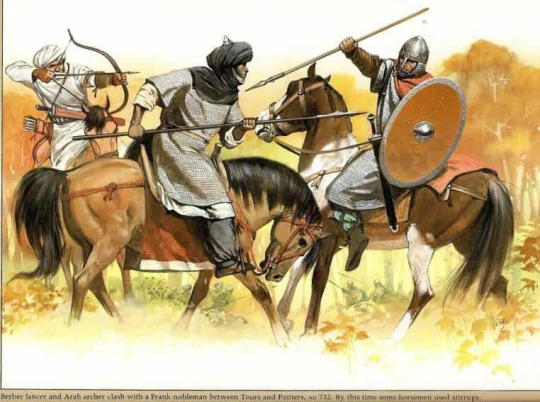
#iberia#spain#portugal#andorra#france#dark ages#middle ages#medieval#visigoths#moors#berbers#roman empire#hispania#arabs#morocco#8th century#cordoba#andalusia#al andalus#sephardic#jews#christians#muslims
24 notes
·
View notes
Text
Los Imperios Moros y Otomanos
En la sociedad moderna, nosotros tenemos derechos humanos básicos que deben ser respetados por todos; algunos derechos son la libertad religiosa y un gobierno justo. Además, durante una guerra, hay crímenes de guerra que no debemos cometer, especialmente con respecto a civiles. En historia, había muchos imperios que tenían mucho éxito. Dos de los cuales parecen muy similares, pero tenían opiniones diferentes de los derechos humanos básicos: el Imperio Moro y el Imperio Otomano. Sus imperios eran muy grandes: Los moros conquistaron el norte de África y España, mientras que los otomanos conquistaron los Balcanes, Egipto y otras partes del norte de África.
Aunque las dos naciones eran islámicas, los otomanos eran de los turcos guerreros, mientras que los moros eran de los bereberes y los árabes; la diferencia de la etnicidad significa que los dos imperios tienen una cultura muy diferente, aunque con algunas conexiones porque los dos imperios hay la misma religión. Por ejemplo, los otomanos conquistaron por las guerras y mataron muchas personas porque eran de turcos guerreros. Por otro lado, los moros tenían más soldados que los defensores de las ciudades Españolas y ofrecieron términos de entrega más generosos. Por eso, menos personas morían comparada a las conquistas de los otomanos. Creemos que habría más muertes si las ciudades españolas tuvieran fuerzas iguales con los moros.

En los dos imperios, los musulmanes eran las personas de primera clase en comparación con los cristianos y los judíos porque los moros y otomanos eran imperios islámicos. Además, los moros y otomanos querían que los habitantes de sus imperios eran musulmanes. Si los habitantes no se convertían, tenían una pequeña opción: podían pagar un impuesto y vivir como habitantes de segunda clase o podían ser ejecutados. Pero, en el Imperio Otomano, había una situación en la que los niños eran obligados a convertirse. Se llamaba "Devşirme", en el que niños cristianos fueron forzados a entrar en el ejército. Los niños entrenaban para ser Jenízaros, miembros de la élite militar y servían al sultán directamente. En el Imperio Moro, los niños y los adultos no tenían que convertirse, incluso cuando eligieron unirse al ejército. Además de la libertad religiosa, las personas que entraban al ejército no necesitaban pagar Jizya, un impuesto por las personas que no son musulmanes. Aunque los moros querían que sus habitantes fueran musulmanes, los moros sabían que entrando el ejército era un servicio a su país. Creemos que los moros respetaban a los habitantes que entrarían en el ejército y arriesgarían sus vidas por el imperio. Los métodos de que los dos imperios conquistaron y gobernaron sus tierras muestran como los otomanos eran más dictatoriales y los moros eran más tolerantes.

Para imaginar la crueldad de los otomanos, mira esta pintura arriba. Este se llama la Caída de Constantinopla y nos muestra a los otomanos asediando Constantinopla. Los otomanos han destruido la hermosa ciudad y sus murallas. Cuando los otomanos capturaron Constantinopla, convirtieron todas las iglesias en mezquitas. Pero, más importante, los otomanos destrozaron Santa Sofía, la catedral más grande, importante, y hermosa de la cristiandad. Además, cuando el Sultán Mehmed II entró la ciudad, es interesante para nosotros que un artículo de BBC dice que el Sultán mató a mucha de la población, pero un artículo de Britannica dice que los otomanos se evitaron matar civiles. Esta contradicción hace que sea difícil de entender qué pasó durante el sitio de Constantinopla, pero tenemos un análisis. Pensamos que los otomanos asesinaron a las personas que no se rindieron. Estos asesinatos tienen sentido porque los otomanos ven a los cristianos como las personas de la segunda clase y es más práctico matar a sus enemigos que dejarlos ser. Sin embargo, aunque los asesinatos son prácticos, son immoral. Por otro lado, los moros ofrecieron términos de la entrega más generosos y no destruyeron las casas, iglesias, y otros edificios como los otomanos. Sin embargo, es posible que los moros no destruyeron los edificios porque ellos no tenían mucha resistencia, y por lo tanto no era necesario. La conquista de España fue relativamente fácil porque muchas de las ciudades aceptaron los términos de entrega y los moros no necesitaban forzar conformidad sobre sus habitantes. Además, los moros eran gobernantes mejores comparados al gobernante anterior, Roderick, quien usurpó el trono y era tiránico. Por eso, los judíos pensaban en los moros como liberadores porque ellos tenían más libertad religiosa con los moros comparada a Roderick. Discutiremos la razón por la que los moros inicialmente enviaron un ejército a España; es intrigante. Hay una leyenda que los moros envió ayuda a España por un pedido de Julian, un conde de quién su hija era seducida por Roderick. Las leyendas se basan en historias, y esta representa la falta de lealtad de los nobles. Los moros querían aumentar su territorio y es probable que invadieran aunque no hubiera ninguna súplica. Como esperarías después de leer esto, mucho menos asesinatos fueron cometidos por los moros comparada a los otomanos.
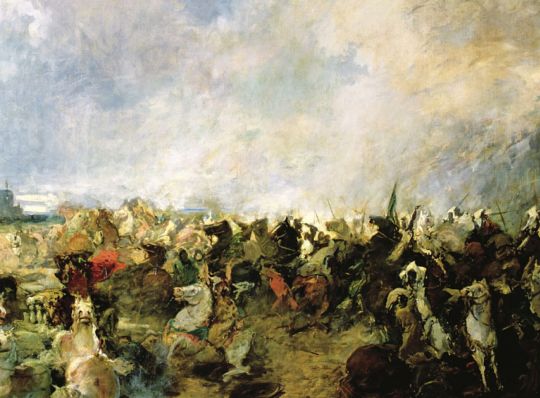
La pintura arriba representa la batalla de Guadalete. Se considera el momento decisivo en la guerra. Los visigodos, los soldados de Roderick, eran doble de los números de los moros, pero perdieron. Aunque las batallas fueron violentas, los moros no mataron civiles ni destruyeron edificios como los otomanos. Este es un mayor contraste desde los otomanos, de quién su batalla decisiva era un asedio donde muchos edificios mayores fueron destruidos y habitantes de Constantinopla fueron asesinados; esto es en parte porque los otomanos tenían cañones y más mejoras tecnología para asedios. Nosotros pensamos si los moros, con la misma tecnología, habrían empezado un asedio o habrían pensado más de los edificios y habitantes. Nosotros discutirán que ellos habrían pensado por los edificios y habitantes. La prioridad de los moros era conquistar el área, pero ellos intentaron no dañar a los habitantes, edificios y la moral de sus habitantes en el futuro.
Para los estándares de hoy, los otomanos y los moros habrían violado muchos derechos humanos básicos. Sin embargo, creemos que los otomanos habían violado más derechos que los moros. Los asesinatos de civiles, las conversiones forzada, la destrucción de edificios, todos de los cuales fueron hechos por los otomanos, serían altamente ilegales e inmorales hoy. Es interesante para nosotros que podamos ver una sociedad, tomar a los moros por ejemplo, como tolerantes, en los que las personas eran discriminadas por la religión y obligadas a vivir vidas como personas de segunda clase. Los moros eran más tolerantes y mucho más considerados con sus habitantes, al menos al principio, que los otomanos. Aunque los otomanos eran crueles según los estándares de hoy, y comparados con los moros, todavía eran relativamente progresistas para su época.
Bibliografía
12, Averill Earls · June. “Devşirme: The Tribute of Children, Slavery and the Ottoman Empire.” DIG, 29 Mar. 2020, digpodcast.org/2018/08/26/devsirme-the-tribute-of-children-slavery-and-the-ottoman-empire/.
“Battle of Guadalete.” Wikipedia, Wikimedia Foundation, 3 Sept. 2020, en.wikipedia.org/wiki/Battle_of_Guadalete.
Celik, Mehmet. “Religious Conversion in Early Post‐Ottoman Bulgaria: A Case Study of Ruse.” Wiley Online Library, John Wiley & Sons, Ltd, 3 Feb. 2020, onlinelibrary.wiley.com/doi/full/10.1111/1467-9809.12641.
Gámbela, Billy. “355-1492 A.D. The Mighty Moorish Empire of North Africa, South West Asia, Iberian Peninsula and The Americas..” Billy Gambéla ጋምበላ ። Afri-Asiatic Anthropology Blog., 19 Aug. 2016, billygambelaafroasiaticanthropology.wordpress.com/2015/08/08/the-mighty-moorish-empire-of-north-africa-south-west-asia-iberian-peninsula-and-the-americas/.
Hudson, Myles. “Fall of Constantinople.” Encyclopædia Britannica, Encyclopædia Britannica, Inc., 22 May 2020, www.britannica.com/event/Fall-of-Constantinople-1453.
“Legends of Medieval Spain.” Visit, www.visit-medieval-spain.com/legends.html.
“Religions - Islam: Muslim Spain (711-1492).” BBC, BBC, 4 Sept. 2009, www.bbc.co.uk/religion/religions/islam/history/spain_1.shtml.
“Religions - Islam: Ottoman Empire (1301-1922).” BBC, BBC, 4 Sept. 2009, www.bbc.co.uk/religion/religions/islam/history/ottomanempire_1.shtml.
Yapp, Malcolm Edward, and Stanford Jay Shaw. “Mehmed II.” Encyclopædia Britannica, Encyclopædia Britannica, Inc., 8 Aug. 2019, www.britannica.com/place/Ottoman-Empire/Mehmed-II.
1 note
·
View note
Photo

Ṭāriq ibn Ziyād (known simply as Tarik in English, was a Berber Umayyad commander who initiated the Muslim Umayyad conquest of Visigothic Hispania (Spain and Portugal) in 711–718 AD. He led a large army and crossed the Strait of Gibraltar from the North African coast, consolidating his troops at what is today known as the Rock of Gibraltar. The name "Gibraltar" is the Spanish derivation of the Arabic name Jabal Ṭāriq, meaning "mountain of Ṭāriq". On or about April 26, 711, his army composed of recent Berber converts to Islam, was landed on the Iberian peninsula by Julian. They debarked at the foothills of a mountain which was henceforth named after him. It should be noted that many modern historians tend to refer to Tarik's garrison as consisting only of Caucasoid Berbers and Arabs. Ibn Husayn of the 10th Century recorded however that many of his troops were "Sudanese". Contemporary accounts of Europeans state of the Moorish invaders, "Their faces were as black as pitch, the handsomest amongst them was as black as a cooking pot." It should be pointed out that the term "Berber," erroneously identified as a racial category, is in actuality a linguistic-ethnic group. There are both Semitic and African Berbers. He was described by contemporary witnesses as having a short stature, brown skin, a hooked nose, and woolly hair. He was said to be a native of Sudan. Thus would begin the Moorish occupation of Spain, to which Europe owes greatly the benefits of the Renaissance, which would last well into the 15th Century. His army contained about 7,000 soldiers, composed largely of Berber stock and Arab troops. Roderic, to meet the threat of the Umayyads, assembled an army said to number 100,000. He won a decisive victory when Roderic was defeated and killed on July 19 at the Battle of Guadalete. He split his army into four divisions, which went on to capture Córdoba under Mughith al-Rumi, Granada, and other places, while he remained at the head of the division which captured Toledo. He continued reaching Guadalajara and Astorga. He was de facto governor of Hispania until the arrival of Mūsā. #africanhistory365 #africanexcellence https://www.instagram.com/p/Cc-iJTMrXVJOTxPQf5_K-0qA0RuWTvkWot0jMg0/?igshid=NGJjMDIxMWI=
3 notes
·
View notes
Text
Events 7.19
AD 64 – The Great Fire of Rome causes widespread devastation and rages on for six days, destroying half of the city.
484 – Leontius, Roman usurper, is crowned Eastern emperor at Tarsus (modern Turkey). He is recognized in Antioch and makes it his capital.
711 – Umayyad conquest of Hispania: Battle of Guadalete: Umayyad forces under Tariq ibn Ziyad defeat the Visigoths led by King Roderic.
939 – Battle of Simancas: King Ramiro II of León defeats the Moorish army under Caliph Abd-al-Rahman III near the city of Simancas.
998 – Arab–Byzantine wars: Battle of Apamea: Fatimids defeat a Byzantine army near Apamea.
1333 – Wars of Scottish Independence: Battle of Halidon Hill: The English win a decisive victory over the Scots.
1544 – Italian War of 1542–46: The first Siege of Boulogne begins.
1545 – The Tudor warship Mary Rose sinks off Portsmouth; in 1982 the wreck is salvaged in one of the most complex and expensive projects in the history of maritime archaeology.
1553 – The attempt to install Lady Jane Grey as Queen of England collapses after only nine days.
1588 – Anglo-Spanish War: Battle of Gravelines: The Spanish Armada is sighted in the English Channel.
1701 – Representatives of the Iroquois Confederacy sign the Nanfan Treaty, ceding a large territory north of the Ohio River to England.
1702 – Great Northern War: A numerically superior Polish-Saxon army of Augustus II the Strong, operating from an advantageous defensive position, is defeated by a Swedish army half its size under the command of King Charles XII in the Battle of Klissow.
1817 – Unsuccessful in his attempt to conquer the Kingdom of Hawaii for the Russian-American Company, Georg Anton Schäffer is forced to admit defeat and leave Kauai.
1821 – Coronation of George IV of the United Kingdom.
1832 – The British Medical Association is founded as the Provincial Medical and Surgical Association by Sir Charles Hastings at a meeting in the Board Room of the Worcester Infirmary.
1843 – Brunel's steamship the SS Great Britain is launched, becoming the first ocean-going craft with an iron hull and screw propeller, becoming the largest vessel afloat in the world.
1845 – Great New York City Fire of 1845: The last great fire to affect Manhattan begins early in the morning and is subdued that afternoon. The fire kills four firefighters and 26 civilians and destroys 345 buildings.
1848 – Women's rights: A two-day Women's Rights Convention opens in Seneca Falls, New York.
1863 – American Civil War: Morgan's Raid: At Buffington Island in Ohio, Confederate General John Hunt Morgan's raid into the north is mostly thwarted when a large group of his men are captured while trying to escape across the Ohio River.
1864 – Taiping Rebellion: Third Battle of Nanking: The Qing dynasty finally defeats the Taiping Heavenly Kingdom.
1870 – Franco-Prussian War: France declares war on Prussia.
1900 – The first line of the Paris Métro opens for operation.
1903 – Maurice Garin wins the first Tour de France.
1916 – World War I: Battle of Fromelles: British and Australian troops attack German trenches as part of the Battle of the Somme.
1936 – Spanish Civil War: The CNT and UGT call a general strike in Spain – mobilizing workers' militias against the Nationalist forces.
1940 – World War II: Battle of Cape Spada: The Royal Navy and the Regia Marina clash; the Italian light cruiser Bartolomeo Colleoni sinks, with 121 casualties.
1940 – Field Marshal Ceremony: First occasion in World War II that Adolf Hitler appoints field marshals due to military achievements.
1940 – World War II: Army order 112 forms the Intelligence Corps of the British Army.
1942 – World War II: The Second Happy Time of Hitler's submarines comes to an end, as the increasingly effective American convoy system compels them to return to the central Atlantic.
1943 – World War II: Rome is heavily bombed by more than 500 Allied aircraft, inflicting thousands of casualties.
1947 – Prime Minister of the shadow Burmese government, Bogyoke Aung San and eight others are assassinated.
1947 – Korean politician Lyuh Woon-hyung is assassinated.
1952 – Opening of the Summer Olympics in Helsinki, Finland.
1957 – The largely autobiographical novel The Ordeal of Gilbert Pinfold by Evelyn Waugh was published.
1961 – Tunisia imposes a blockade on the French naval base at Bizerte; the French would capture the entire town four days later.
1963 – Joe Walker flies a North American X-15 to a record altitude of 106,010 meters (347,800 feet) on X-15 Flight 90. Exceeding an altitude of 100 km, this flight qualifies as a human spaceflight under international convention.
1964 – Vietnam War: At a rally in Saigon, South Vietnamese Prime Minister Nguyễn Khánh calls for expanding the war into North Vietnam.
1967 – Piedmont Airlines Flight 22, a Piedmont Airlines Boeing 727-22 and a twin-engine Cessna 310 collided on July 19, 1967, over Hendersonville, North Carolina, USA. Both aircraft were destroyed and all passengers and crew were killed, including John T. McNaughton, an advisor to Robert McNamara.
1969 – Chappaquiddick incident: U.S. Senator Ted Kennedy crashes his car into a tidal pond at Chappaquiddick Island, Massachusetts, killing his passenger Mary Jo Kopechne.
1972 – Dhofar Rebellion: British SAS units help the Omani government against Popular Front for the Liberation of Oman rebels in the Battle of Mirbat.
1976 – Sagarmatha National Park in Nepal is created.
1977 – The world's first Global Positioning System (GPS) signal was transmitted from Navigation Technology Satellite 2 (NTS-2) and received at Rockwell Collins in Cedar Rapids, Iowa, at 12:41 a.m. Eastern time (ET).
1979 – The Sandinista rebels overthrow the government of the Somoza family in Nicaragua.
1979 – The oil tanker SS Atlantic Empress collides with another oil tanker, causing the largest ever ship-borne oil spill.
1980 – Opening of the Summer Olympics in Moscow.
1981 – In a private meeting with U.S. President Ronald Reagan, French President François Mitterrand reveals the existence of the Farewell Dossier, a collection of documents showing the Soviet Union had been stealing American technological research and development.
1982 – In one of the first militant attacks by Hezbollah, David S. Dodge, president of the American University of Beirut, is kidnapped.
1983 – The first three-dimensional reconstruction of a human head in a CT is published.
1985 – The Val di Stava dam collapses killing 268 people in Val di Stava, Italy.
1989 – United Airlines Flight 232 crashes in Sioux City, Iowa killing 111.
1992 – A car bomb kills Judge Paolo Borsellino and five members of his escort.
1997 – The Troubles: The Provisional Irish Republican Army resumes a ceasefire to end their 25-year paramilitary campaign to end British rule in Northern Ireland.
2012 – Syrian civil war: The People's Protection Units (YPG) capture the city of Kobanî without resistance, starting the Rojava conflict in Northeast Syria.
2014 – Gunmen in Egypt's western desert province of New Valley Governorate attack a military checkpoint, killing at least 21 soldiers. Egypt reportedly declares a state of emergency on its border with Sudan.
0 notes
Text
Roderick 𐌷𐍂𐍉𐌸𐌰𐍂𐌴𐌹𐌺𐍃
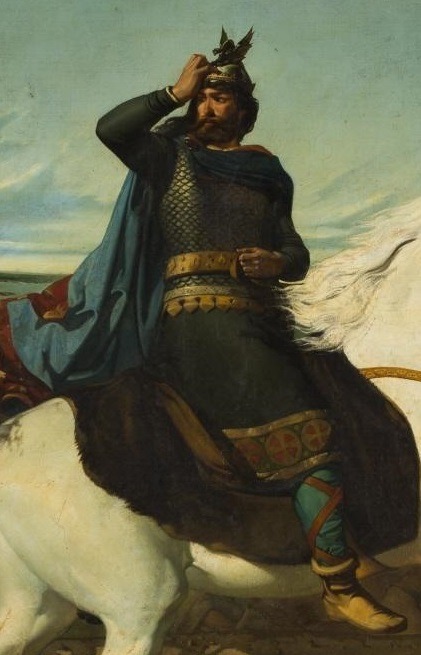
El Rey Rodrigo - Marcelino de Unceta.
The last Visigoth king of hispania Roderick, 𐌷𐍂𐍉𐌸𐌰𐍂𐌴𐌹𐌺𐍃 in gothic, is died the 19 July 711 with the visigothic kingdom in the battle of Guadalete. Despite a strong resistance, he was deafeted by Tariq Ibn Ziyad and his arabo-berbers troops, he's drowned while trying to flee.
15 notes
·
View notes